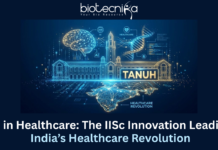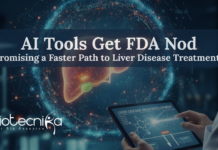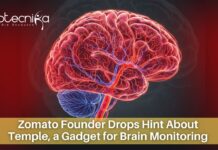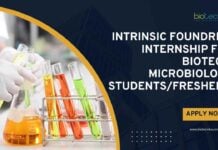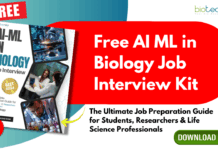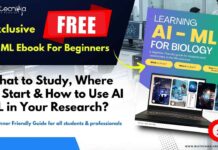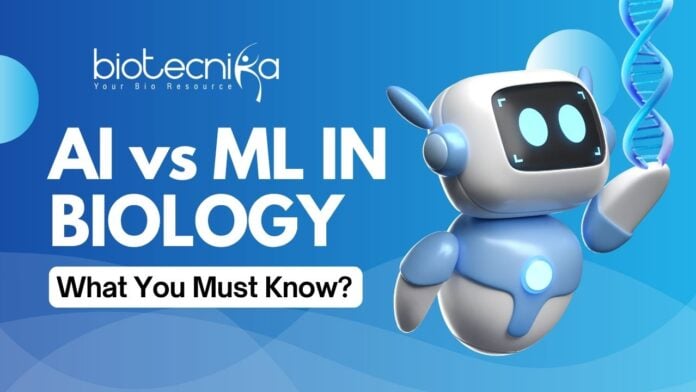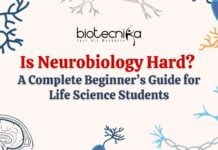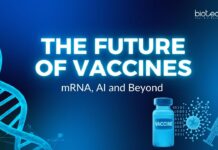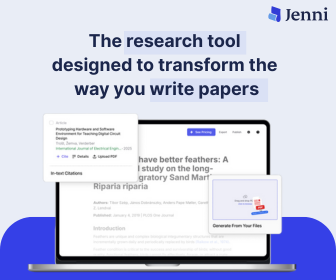Table of Contents
Artificial Intelligence and Machine Learning in Biology
As we know, AI and ML have gained widespread attention in the realm of computing, and applications abound, that is beyond the areas of software and robotics. They are transforming the fields of drug discovery, diagnosis, and biological research. Biologists, researchers, and students can all benefit from realizing differences and complementarities between AI and ML. This article examines the fundamental principles of artificial intelligence and machine learning, how they are different, and how one can begin to become skilled in such potent tools in order to advance biological research.
What is Artificial Intelligence?
Artificial intelligence describes an imitation of human cleverness in computers that have been educated to think, learn, and make decisions. In simple terms, it is the art of making machines “think and act” similarly to humans. AI enables computers to do tasks that typically demand human vision, intellect, and problem-solving ability.
AI plays a critical role in biology for uses like analyzing vast datasets, detecting patterns, and forecasting outcomes. For example,
- Genomics: AI systems are able to forecast gene relations, protein structures, and gene functions by searching enormous genomic databases.
- Drug Discovery: AI systems are able to forecast gene relations, protein structures, and gene functions by searching enormous genomic databases.
- Medical Diagnostics: AI systems are able to forecast gene relations, protein structures, and gene functions by searching enormous genomic databases.
AI comes in two forms. General AI which is intended to perform any intellectual function that a human can perform. Narrow AI which is specialized to perform a single task.
The majority of the applications in biology now use narrow AI, and they are specialized for specific problems like gene studies or disease identification.
What exactly is Machine Learning?
Machine learning is a category of artificial intelligence in which, through certain processes and algorithms, machines have the ability to learn from experience, gradually getting better without explicit programming. The ultimate objective of machine learning is to provide algorithms with the ability to learn from the given data for making decisions or predictions based on the knowledge/data given.
Machine learning has numerous applications in biology. For instance,
- Protein Structure Prediction: Machine learning algorithms can predict protein three-dimensional structures from amino acid sequences.
- Drug Target Identification: ML algorithms help identify potential drug development targets by analyzing biological information.
- Environmental Biology: ML is applied to model ecological systems, predict species behavior, and analyze how ecosystems are influenced by climate change.
ML uses large datasets to train models. For example, a model can be trained to recognize ill cells from thousands of microphotographs, and the more data for the model, the better it will perform. Supervised learning, unsupervised learning, and reinforcement learning are common machine learning methods, and all have another perspective on biological data..
What’s the Difference Between AI and ML?
Although they are similar, AI and ML are not the same. It is essential for anyone who is engaged in biology or a related field to comprehend these differences.
| Aspect | Artificial Intelligence | Machine Learning |
| Definition | Machines mimic human intelligence | A subset of AI that allows machines to learn from data. |
| Goal | Imitate Human decision-making and problem-solving | Detect patterns in data and make predictions. |
| Data Requirement | May or may not be based on data | Depends greatly on data |
| Functioning | Works according to rules or based on logic to make decisions. | Enhances performance via experience |
| Application Example | Medical robots with AI | ML model for cancer risk prediction |
| Human Intervention | Limited once set up | Trained and tuned |
| Scope in Biology | Wide (AI-powered labs, automation) | Narrow (data-based biological predictions) |
In simpler words, AI is the broader idea while ML is a method to achieve AI. If AI is the mind, then ML is how it acquires learning from experiences.
Are they Same or Different?
A lot of individuals are misled to believe that AI and ML are one and the same. Though they are connected, they have different functions. The main goal of AI is the simulation of intelligent behaviour in machines. And on the other hand, Machine learning is one way of teaching machines to handle AI tasks by using data.
To better explain, put yourself in a biology lab aiming to detect cancer cells:
- AI Approach: The machine can be programmed to scan slides and sort cells on the basis of patterns it has learned or predetermined standards.
- ML Approach: The greater number of slides scanned, the more the machine learns from all of them and can accurately sort cells.
It can be said that “Not all machine learning is AI, but all AI is machine learning”. Some AI machines do not learn from data; instead, they work based on predetermined standards and rules.
How does AI and ML Interact in Biological Research?
ML and AI play in tandem to expedite biological breakthroughs. ML allows systems to learn from biological information and learn from experience, while AI gives the foundation for smart reasoning and decision-making.
ML models are used in research to identify hidden patterns in large datasets, including protein structures, gene codes, and medical images. AI uses these results to direct experiments, automate studies, and create predictions. Both create a continuous cycle of data, learning, and decision-making where ML models are trained against fresh data, which makes AI smart.
Examples include:
- Protein structure prediction: AI software like AlphaFold simulates complex protein folding with machine learning.
- Drug discovery: AI forecasts potential drug leads, while ML discovers molecule–target interactions.
- Medical imaging: ML trains AI systems to properly detect diseases from scans.
- Personalized medicine: Both collaborate to analyze patient data and suggest personalized treatments.
The synergy of artificial intelligence and machine learning gives rise to quicker, more precise, and more data-intensive biological studies, paving the way for breakthroughs in environmental science, genetics, and medicine.
Future Scope of AI and ML in Biology
Machine learning and Artificial Intelligence are bringing in new advances and changing the future in biology. The two will drive faster discovery and smarter solutions across the realms of environmental science, agriculture, and medicine as biological data keeps growing.
Precision medicine, where the treatments are customized to an individual patient’s personalized genetic makeup, will be enabled by AI and ML. Predictive modeling will also accelerate and make drug discovery cheaper.
They will enhance the precision of gene editing, split complex DNA sequences, and uncover new genetic data in genomics.
Smart labs powered by AI will accelerate research with minimal human mistakes by automating experiments and examining data in real time.They will revolutionize early diagnosis and disease forecasting in the medical sector by detecting health risks long before symptoms appear.
The impact of AI and ML will extend to environmental biology, where they will assist in the tracking of ecosystems and biodiversity, and agriculture, where they will optimize crop health and production.
As technology progresses, ethical AI practices that ensure data equity and privacy will substantially contribute to responsible innovation.
Essentially, a harmonious integration of AI and ML will define the future of biology by facilitating a data-based, intelligent, and foresighted way of knowing life and improving human health.
How to actually learn AI and ML for biology?
While it may look tough to learn AI and ML, you can do so if you approach it in a structured manner. This is a comprehensive guide for anyone who wishes to become a budding biologist:
- Build a Strong Foundation
It is important to learn programming, statistics, and mathematics prior to venturing into AI and ML. Essential topics include:
- Linear Algebra – Essential in understanding models and algorithms.
- Probability and Statistics – Significant in interpreting biological data.
- Python or R Programming – Familiarity with the programming languages that is commonly used for AI and ML development.
- Study Biological Data Analysis
Learn biological databases, e.g., clinical data, protein structures, and genomic sequences. Practice with free biological databases on websites like NCBI, EMBL-EBI, and Kaggle.
- Learn Machine Learning Algorithms
Begin with the fundamentals like:
- Supervised Learning: Making predictions using the labelled data and is highly considered.
- Unsupervised Learning: Finding out the hidden patterns within the data.
- Reinforcement Learning: For learning models that rely on trial-and-error processes
- Popular machine learning libraries, such as Scikit-learn, TensorFlow, and PyTorch, provide ready-to-use tools for implementing these methods.
- Apply AI/ML to Biological Problems
Practical experience is essential. Work on projects like:
- Predicting disease risk with patient data.
- Protein folding and interaction modeling.
- Cell type classification based on microscopy pictures.
- Take Online Courses and Certifications
Numerous platforms provide biology-specific AI and ML courses.
- Biotecnika: It provides AI & ML in Biology, Bioinformatics, Computational Biology, Industrial Training Program with Project Work + Paper Publication Assistance.
- General Courses: Swayam NPTEL, IIT Madras, provides AI & ML in Biology Courses virtually.
- Join Research Communities
Join communities such as GitHub projects, Bioinformatics.org, and AI in Healthcare forums to collaborate, share ideas, and follow developments.
The field of life science is being revolutionized because of artificial intelligence and machine learning. Machine learning gives computers the ability to learn through experience and perform better, while artificial intelligence is concentrating on making the machines mimic the human mind.
It is crucial for biologists, students, and researchers who plan to utilize AI and ML to be aware of their similarities and differences. You can assist in creating a world in the future where technology and science thrive by becoming an expert that will advance discoveries in genomes, drugs, personalized medicine, and environmental biology.
The future of biology is enormous, and this is the perfect time to begin, regardless of your level of experience or interest to incorporate AI and ML into practice.


